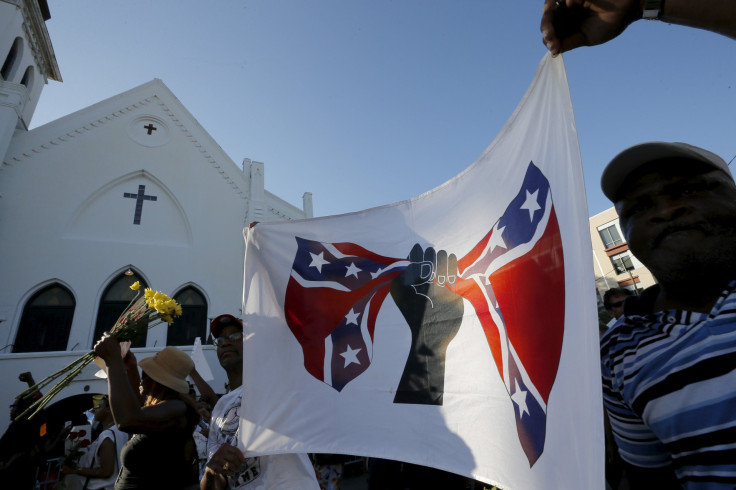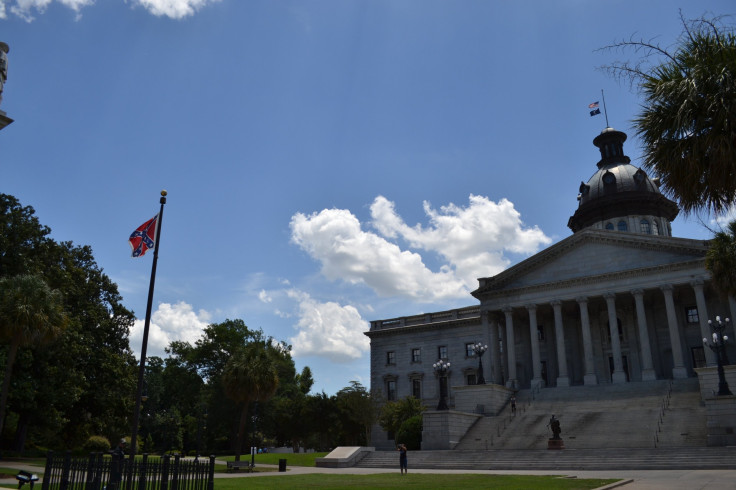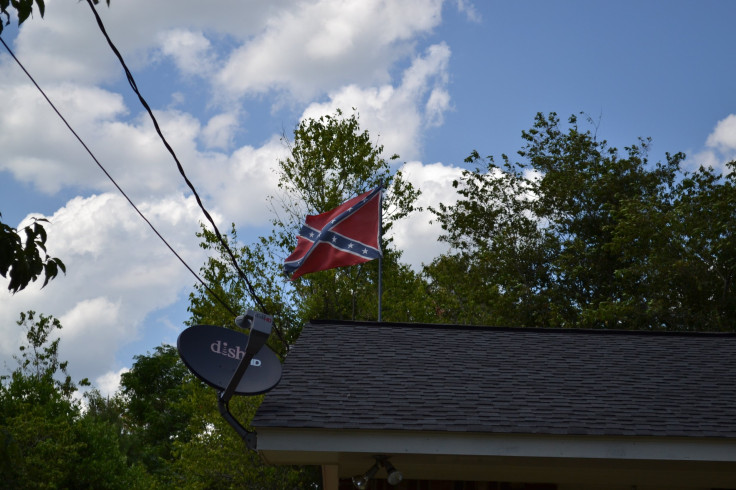South Carolina Confederate Flag Controversy: Overlooking History, Locals Raise Flag Symbolizing Racial Oppression

EASTOVER, South Carolina -- Mack McElveen wishes he could fly the flag of the Confederacy, the rebel banner representing the southern half of the United States that lost the Civil War to its northern neighbors 150 years ago, at his sky-blue ranch home. But he said he's afraid.
McElveen falls into a stubborn constituency whose undying allegiance to the Confederate flag has reignited controversy as the symbol of Southern pride flies high near the State Capitol in Columbia, South Carolina, after Dylann Roof shot and killed nine members of a prayer group at a historic black church Wednesday night in Charleston, about 120 miles away. Despite the flag's historic origins as the symbol of the South fighting to preserve slavery, many in rural communities here tend to deny the connection between a past scarred by brutal oppression and what they see as proud Southern heritage, even when they espouse ideas that recall the state's racist history.
"They'd probably shoot my house up," McElveen, 62, a white supervisor at Budweiser, said about flying the Confederate flag. And by "they," he meant African-Americans, who make up roughly 92 percent of the residents in Eastover, where the population at last count was 813. The tiny rural community in central South Carolina is made up of cornfields, abandoned ramshackle dwellings and modest one-story homes. It's also Roof's last known address before the fatal shooting.
In the wake of the massacre, civil rights activists, politicians and academics have denounced the Confederate flag as an enduring symbol of racism and hatred. "The flag, and the war, was about enslavement and property," said Kevin Alexander Gray, a longtime black rights activist who lives in Columbia, yet "the country is in historical denial."
Roof carried the Confederate flag, photos posted to a website discovered Saturday showed, and he drove a car with a license plate bearing several versions of it. He prayed with members of the Emanuel African Methodist Episcopal church for about an hour before opening fire and killing nine people, including the pastor. He was arrested in North Carolina the next day.
'Part Of Our History'
The flag originally represented General Robert E. Lee's Army of Northern Virginia, the primary Confederate force in the eastern battle zone of the Civil War. Other battalions carried flags of different designs, but it is the banner for "Lee's Army" that today remains as the symbol of the Confederacy.
A full century after the Civil War ended, the flag became a symbol of defiance once again in South Carolina in the wake of civil rights efforts in the 1940s and 1950s. In 1962, the blue X, embedded with 13 white stars and laid against a red background, topped the State House in Columbia for the first time.

Calls for the flag's removal from the top of the statehouse eventually resulted in its relocation to a flagpole outside the building in 2000. This week, even though the South Carolina and U.S. flag have been lowered to half-staff following the killings in Charleston, the Confederate flag remains at full staff because state lawmakers, the only people with the authority to change how it flies, are out of session until January.
But in the tiny communities nestled in the long rural stretches between South Carolina's major cities, where highways coast past vast fields of red earth zippered into taut rows of seedlings, or weave through commercial patches of alternating dollar stores and used car lots, the debate over the flag's anguished, fraught history is one many were keen to claim was overblown.
"People put too much emphasis on symbolism," McElveen said, tugging at a pair of work gloves as he prepared a chainsaw to cut down part of a massive live oak tree in his front yard whose trunk a storm the previous night had split in half.
McEleveen said he was born in South Carolina and had lived in Eastover for the past three decades. "It's important because it's part of our history," he said of the confederate symbol. "This flag doesn't have anything to do with what happened this past week."
He said he had never checked the family book sitting inside his home, but he was sure he had ancestors who had fought in the Civil War.
"Next thing that's going to happen is we're not going to be able to fly the American flag because of all the people that are immigrating," he said. "The way the world's changed, it's almost reverse discrimination against us."
Gray said such sentiment was common among people who still supported the flag. "They have no clue what white privilege is," he said. "They believe they're victims."
'Always Have, Always Will'
A tattered Confederate flag flapped in the breeze from a pole jutting off the top of the one-story, red brick home of Jeff Nance in the predominantly white community of Gaston 15 miles south of Columbia on Saturday. The red had faded and its free end was dangling in ragged strips. Nance, who said his ancestor James Nance fought as a colonel in the Civil War, used to fly an American flag beneath the Confederate one, until it rotted off six months ago.

Nance, a 52-year-old pipe fitter who spoke with a tone of resigned apathy, as if flying the flag were tantamount to growing tomatoes, said it had nothing to do with hatred toward black people. He could see how the flag might be construed as racist, he said, scratching languidly at the scruff of his mustache. But to him, it wasn't. "It's just history," he said. He'd lived in South Carolina his entire life, and he had always flown the flag. "Always will," he added.
Others, like Ernie Roberts, 45, of Eastover, spoke more fiercely. A self-proclaimed racist who said he flew the Confederate, American and South Carolina flags at his home, he sported a Harley Davidson doo rag wrapped snugly around his head. A deliveryman for Budweiser, he spoke in binaries of "we" -- whites -- and "they" -- blacks - and frequently used the N-word to describe people who, he maintained, drained public resources by living off food stamps and refusing to work.
"The rebel flag is our heritage," he said Saturday morning as he took a swig from a Budweiser bottle wrapped in stripes of red and white. "We're Southerners," and the Confederate flag represents the Southern way, he said. And what was that, exactly?
"You respect everybody. You work hard. And you have good work ethics and you take care of your family and your loved ones," he said -- characteristics he did not ascribe to most black people.
Dorothy Davis, 74, a grandmother whose Gaston home had a fresh Confederate flag flapping prominently on a roadside flagpole in front of her modest brick ranch, did not see why the flag was so controversial. "It does not represent race as far as I'm concerned," she said. Davis had lived her entire life in South Carolina and in Gaston since 1979. Her father was a sharecropper, and "back then, people didn't talk about stuff" like racism and slavery, she said.
A sticker with the Confederate flag was pasted to a piece of piping in a dilapidated porch area behind the house, but Davis dismissed the idea of it symbolizing much of anything -- it was just something her husband had brought home, she said.
This decoupling of the concept of history and the actual lived history of enslavement and oppression in the South and South Carolina is what is so troubling to those who study the topic or push for equal rights.
Yet Cinderella Branham, 65, a black woman who has lived in or near Eastover her entire life, said the flag did not bother her although she rarely saw it flown in her area.
"A lot of people say it's a sign of hatred," she said. "People [are] going to do what they want to do anyway." The buzz of locusts permeated the muggy air around her one-story brick house, where Branham was relaxing in a chair on a stoop the size of a large shower stall. She sat in a black nightgown starred with tiny white polka dots, and around her wrist was a thin, magenta stripe of rubber, with "peace" inscribed in white cursive.
Branham, who said she used to work cleaning a nearby hotel as well as in the homes of white people, was "pretty sure" some of her ancestors had been slaves. But she was ready to move on. "Ain't no hate in my heart," she said. "You just have to forgive people."
© Copyright IBTimes 2024. All rights reserved.




















